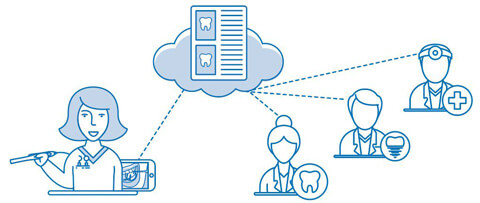
Teledentistry is the future of dental care and believe it or not, the future is here. Using telecommunications, we can provide enhanced dental care, dental consultations, education and increase overall public awareness of the importance of oral health. We can even generate new patients and revenue streams. In this article we will share with you why asynchronous teledentistry is the most popular teledentistry method and how you can get involved in one of the most innovative aspects of the dental field.
What is Asynchronous Teledentistry?
Asynchronous teledentistry involves recording a patient’s clinical information and transferring the data to another dental professional at a separate location. This is also known as ‚”store and forward.‚” With asynchronous teledentistry we can safely and securely share patient information, including radiographs, intraoral photos and clinical data with dental or medical providers for a full evaluation that the doctor can complete remotely.

This allows us as dental professionals to streamline treatment planning, efficiently connect with our referral network, increase patient touch points and create better access to dentistry for more patients.
Being More Efficient
When using the asynchronous approach of teledentistry, we can be more efficient with the time we have with our patients. Time is a hot commodity in the dental office, so being able to access all the information we need in a timely manner is essential. So how does the asynchronous method save us time? When information from previous visits with our office and visits with specialists are readily available, we get a full, clear picture of the patient, their treatment plan and their goals. Having this information allows us to better treat our patients in a timely manner.
Speaking of being more efficient, utilizing asynchronous teledentistry makes connecting with our referral network a breeze. A referral network will, of course, include the general dentist, orthodontist, endodontist, periodontist and oral surgeon but can also include physicians, cardiologists, orthopedists and any other specialist. Having records or input from all of a patient’s providers helps create that clear picture of the patient that we need to better care for them.
As an example, say a patient sees an endodontist to evaluate a tooth for a possible root canal. The endodontist will create a treatment plan and perform any necessary treatment. Following the procedure, the endodontist will record the treatment completed and send that, along with any radiographs, post op reports or follow up instructions directly to the general dentist. You may be thinking, ‚”That’s what my office already does.‚” Well then, congratulations! You are already utilizing the asynchronous approach of teledentistry. When this is done immediately after the specialist completes treatment, and you can check on the patient right away, then a care team has elevated care for that patient.
Here’s another example that may be something you aren’t already doing. Say a patient presents in your office and while updating health history information the patient tells you nothing has changed. However, this patient had a knee replacement 4 months ago and failed to mention it. If your patient’s orthopedist was in your referral network, you would already have that information prior to the patient being seen in your office. You would have known ahead of time that this patient would require a premedication based on their orthopedist’s recommendation.
When providers share the patient data they collect, everyone benefits. Doctors and their teams benefit by streamlining appointment times and improving their workflow, while patients benefit by having all their providers be on the same page in caring for them.
Access to Dental Care
Using asynchronous teledentistry you can connect with your referral network to share information between providers, but another huge benefit is having the ability to connect underserved patients with the dental care they need.
Asynchronous teledentistry allows underserved patients better access to dental care. This is especially helpful for patients living in rural areas, where there are fewer dental providers, more elderly people and low (or no) dental coverage by insurance.
With teledentistry, many hygienists are opting to serve their rural communities by collaborating with dentists remotely. With this method, a hygienist can see a patient, record all diagnostic information and send the data to their collaborating dentist for review and treatment planning. Many patients are benefiting from this type of care because they are able to seek dental treatment more conveniently and at a lower cost. Based on supervision rules in your state’s dental practice act, there may be more opportunities for the dental hygienist to provide billable preventive care services and see patients in a range of settings.
By implementing asynchronous teledentistry, we can care for more patients, no matter their location, in the most efficient way possible. To learn more about how you can get setup for teledentistry, read more about TeleDent.
